Laptop Graphics Face Off: Diablo III Performance
by Jarred Walton on May 26, 2012 4:25 AM ESTDetailed FRAPS Runs and Closing Thoughts
For those of you that want a different view of the gaming action, we’ve selected the highest quality but still playable result for each GPU. In general, that means we wanted average frame rates of 25 or higher, with minimum frame rates always above 15 FPS. Obviously you could tweak settings in other ways and still get playable results (e.g. by dropping the resolution, you might be able to run our Enthusiast settings at 1366x768 instead of Mainstream 1600x900), but we’ve stuck with our three basic categories for the following charts. We’ve ordered them in terms of increasing performance/quality.
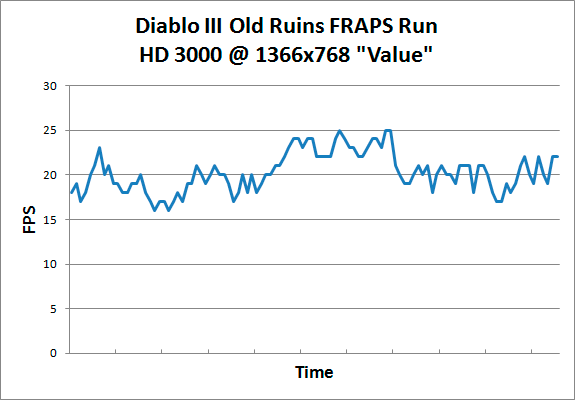
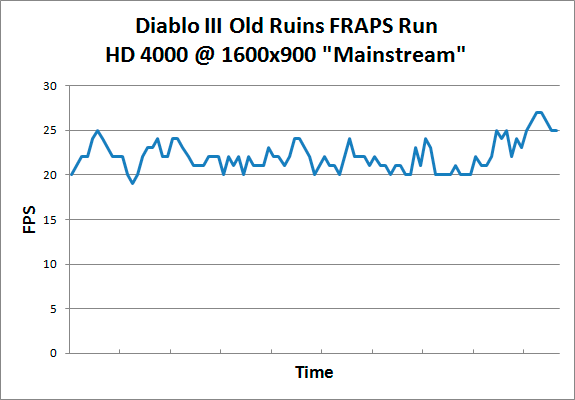
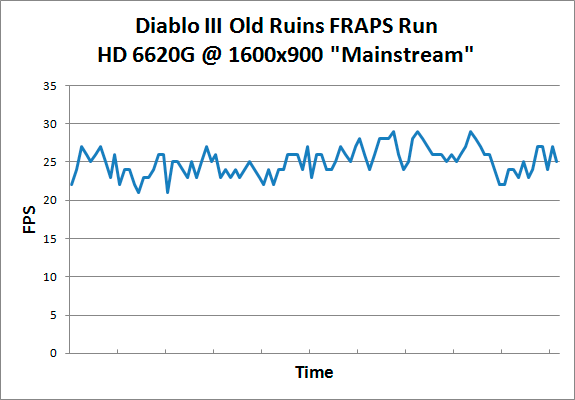

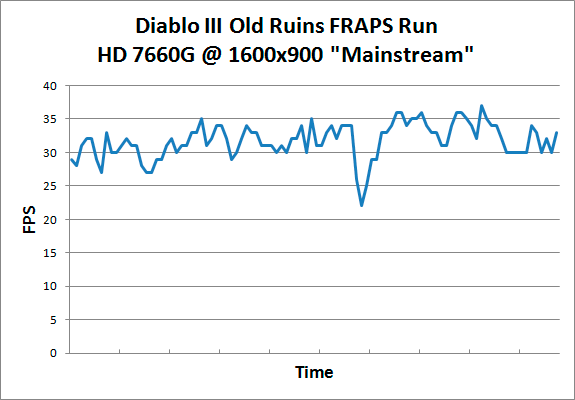

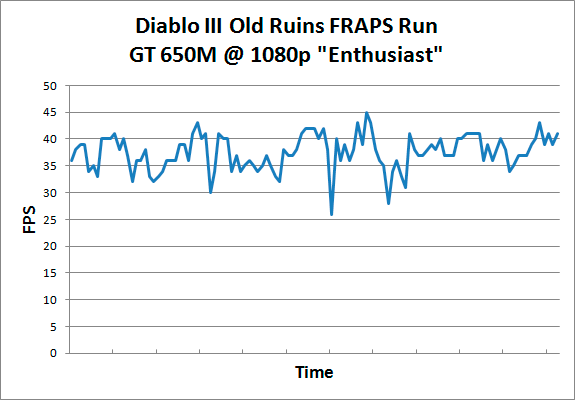
Given what we’ve said already, your best results will generally come by keeping minimum frame rates above 20. Assuming there are other segments of the game that will be more taxing than our benchmark sequence, you might still drop into the upper teens, but as long as you’re above 15 FPS you shouldn’t “lose sync”. Even at our Value settings, HD 3000 is already dangerously close to dropping below 15 FPS at times; you might have to give up on Shadows altogether to get acceptable performance. HD 4000 at our Mainstream settings ends up staying above 20 FPS for the most part but rarely gets above 25 FPS; by comparison, Llano’s HD 6620G ranges from around 22 FPS to nearly 30 FPS. For a smoother experience, though, you’ll still want 30 FPS or more, and that’s where the HD 6630M and Trinity’s HD 7660G fall, with Trinity averaging just slightly better performance despite one large dip to the low 20s.
As shown in our earlier charts, the real winner in terms of gaming performance looks like NVIDIA, though the use of Ivy Bridge CPUs for our two fastest test laptops leaves room for debate. The Acer doesn't appear to have any real issues with throttling in this game, however, despite my earlier fears; it looks like Diablo III (at least early on) just doesn't tax the CPU enough to routinely need more than a moderate 1.2-1.6GHz on the i5-2410M. The 15~20% performance advantage of the N56VM over the 3830TG instead comes from a higher clocked GPU, despite earlier indications that the opposite was the case.
Closing Thoughts
Wrapping up, while Diablo III isn’t the most demanding new release, it can still bring basic laptops to their knees. Unfortunately, unlike desktops it’s often not possible (or at least not practical) to upgrade a laptop’s graphics capabilities. I’ve had a couple friends ask for help with running Diablo III on their old Core 2 Duo laptops, and they’re basically out of luck unless they want to purchase a new system. That’s something we’ve tried to explain in our laptop reviews, and Diablo III drives the point home: buying at the bottom of the barrel in terms of GPU capabilities may not matter for you right now, but kids and/or future applications may eventually make your IGP-only laptop insufficient.
In the case of Diablo III, even a moderate HD 3650 or GT 330M should still be able to handle the game in single player on Normal difficulty, but IGP solutions from two or more years back are likely going to come up short. Naturally, anything faster than the GPUs we’re testing here will allow you to increase details/resolution, and it’s nice to see “mainstream” mobile GPUs like the GT 540M/GT 630M able to handle 1080p gaming for a change.
And again, in case you missed it, the later stages of the game, particularly on Hell difficulty level, are said to be quite a bit more strenuous. If you're the type of player that intends to defeat Diablo not once but three or more times at increasingly difficult settings, our results from early in the game are probably not representative of what you'll experience later. Performance does appear to stay relatively consistent among the various GPUs, though, so if you take half of our performance results as a baseline of what to expect, you're probably not far off the mark.










87 Comments
View All Comments
JarredWalton - Saturday, May 26, 2012 - link
This is the whole purpose of having three different settings, discussing what settings we selected and why, etc. Consider the Value setting a "near-best-case" result while still looking decent; in this case, the only thing you can really do to further improve frame rates is to turn off shadows and/or lower the resolution further. If you look at our Mainstream results, you can see what happens as you start to turn up the dials, and the same goes for Enthusiast. I've discussed in the article exactly how much the various elements impact performance, going so far as to include additional results at "Enthusiast 1080p" but with Shadow Quality on Low/Off.If someone can't get at least a decent idea of where to start in terms of settings and what to expect from their laptop hardware with the information in this article, I'm not sure what I could do to help the situation. Hold their hand and walk through each and every specific setting? Because that tends to come off sounding very condescending if I write that way, and I think most people who care enough to read our articles are much smarter than that.
kyuu - Saturday, May 26, 2012 - link
Fair enough, I understand that. However, I'm not suggesting you write in a hand-holding, condescending manner. Just having three bars on the graph for each resolution (one bar for value, mainstream, and enthusiast settings) would be fine. I understand the time constraints, though, as I said. That would be the ideal, however.CeriseCogburn - Saturday, June 2, 2012 - link
You won't have to worry about that soon for nVidia chipped laptops as nVidia is rolling out that automatic best game play settings in their drivers.That's going to be a wonderful thing for the majority of gamers and laptop users who don't have a clue on game settings - I hope it helps increase the user base so computer games overall gain strength.
Amd needs to follow suit quickly, to help all of us with a larger user base, instead of being stupid and lame on the driver side as usual. Of course, I'm scowling at the idea amd could possibly man up in that area.
gamoniac - Saturday, May 26, 2012 - link
Even though HD4000 is barely playable, I am still impressed by how far Intel has come along. HD4000 is right on the heel of HD6620G, which I didn't expect to happen just 1.5 years ago.geogerf - Saturday, May 26, 2012 - link
Where's the Alienware laptop comparisons...? I have a M17X R3 6900M and D3 is pretty smooth (sorry didn't download FRAPs yet), but I'd like to see some official numbers.Thanks!
erple2 - Sunday, May 27, 2012 - link
Just as soon as that Alienware laptop comes down in price to sub $700 prices, it'll show up on this comparo!Oh, it's not that much in retail? I guess that your Alienware doesn't qualify as a "mainstream" laptop, like these other ones.
geogerf - Monday, May 28, 2012 - link
Sorry, I don't get your sarcasm.. where does it say in the article that these are only sub $700 laptops tested?I'd think Alienware would fit under a "Enthusiast" machine, being gamer oriented and all...
Alchemist07 - Monday, May 28, 2012 - link
I think the ASUS laptop is $1300 or so (was reviewed recently iirc)designerfx - Sunday, May 27, 2012 - link
higher levels get substantially more performance impacting.I'm using a HD 6970 at 1920x1200 with 6 gigs of ram and and an i7 920 and by hell difficulty I've encountered packs of mobs that have brought my machine to it's knees (sub 15FPS).
Blizzard really needs to work on whatever they did poorly with for othis game.
Zingam - Monday, May 28, 2012 - link
Shut the F up and lower that resolution!